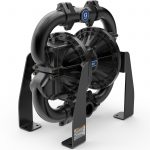The pneumatic diaphragm pump is a kind of positive displacement pump que funciona através do ar comprimido, ou seja, sem a necessidade de energia elétrica para bombear. Para que isso seja possível, ela utiliza uma válvula pneumática conhecida como diafragma que direciona o ar comprimido conforme a bomba opera.
Graças a sua funcionalidade e versatilidade, as bombas pneumáticas de diafragma consegue bombear líquidos com diversos níveis de viscosidade e consoles em suspensão, permitindo a sua aplicação em operações de diversos tipos e em diversas indústrias. O seu design simplificado e os incorporation materials they also allow the safe pumping of abrasive fluids and chemicals, preventing leaks and ensuring even more efficient operation.
What are the components of pneumatic diaphragm pump?
To be able to pump fluids efficiently, the pneumatic diaphragm pump depends on some essential components, as we will see below:
- Fluid chamber: the main function of the fluid chamber is to store the volumes of fluid that are aspirated and pumped. Depending on your pump model, these cameras also include a ball housing store that functions as a check valve.
- Central Structure: the central structure of your pneumatic diaphragm pump includes the air inlet and outlet that is supplied by the pneumatic exchanger, and responsible for the air pressure necessary for the pump to operate.
- Air valve: the air valve is responsible for directing compressed air directly to the fluid chambers and testing the membranes of the pneumatic diaphragm pump.
- Collectors: attached to the external cameras to provide sealing, the collectors are part of the connection interface of your pump system.
- Diaphragms: the diaphragm is the most important structure of your pump, and can be found in different materials and designs. They function both as a sealing barrier to separate the fluid from the dry part of the pump and also to pump this same fluid.
How the pneumatic pump works in practice
Now that we understand what the main components of the pneumatic diaphragm pump are and how they are part of the structure of your equipment, we can understand how it works. The operating cycle of the pneumatic diaphragm pump is based on the use of compressed compressed air to drive the equipment, using two flexible membranes mounted on a shaft that, when moving back and forth, pump fluids in and out of the fluid chamber. .
The cycle of your pneumatic diaphragm pump is separated into three distinct phases:
Phase 1: In the first stage, the air passes through the hole in the pump body and reaches the central ring, where the diaphragm, when driven by air pressure, moves the liquid into the collector.
Stage 2: In the second stage, the pump spool crosses the opposite side of the pneumatic exchanger and slides along the shaft, sending the other air chamber with compressed air pressure.
Phase 3: in the discharge phase, the air chamber that was under previous pressure now finds an open passage. In this way, the pull of the opposite membrane retracts while creating a vacuum, allowing fluid to rise and fill the chamber.
Pneumatic diaphragm pumps are highly versatile equipment that can be implemented to pump different types of fluid. For this reason, before choosing pumping equipment for your industry, check which pneumatic diaphragm pump can be implemented in your operation and what benefits it can deliver to your industry.
One of the biggest advantages of this equipment is that it has a self-priming function and can be positioned above the fluid level and suck it up even when running dry. It can also be installed submerged, especially in well emptying operations. Its versatility demonstrates that it is an extremely practical and cost-effective piece of equipment, in addition to having a low purchase cost.
Know the DOUBLE DIAPHRAGM PNEUMATIC PUMPS – HUSKY 2150 – GRACO










